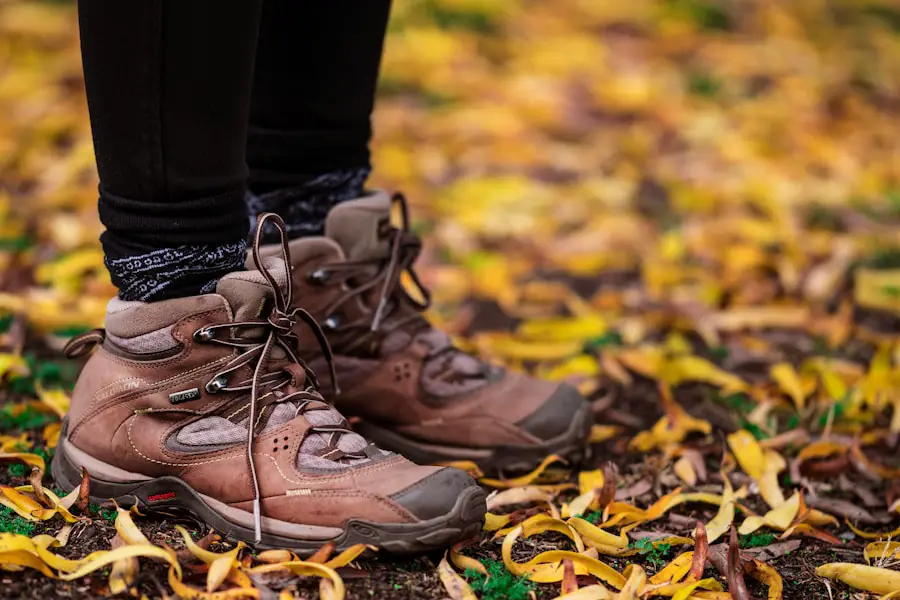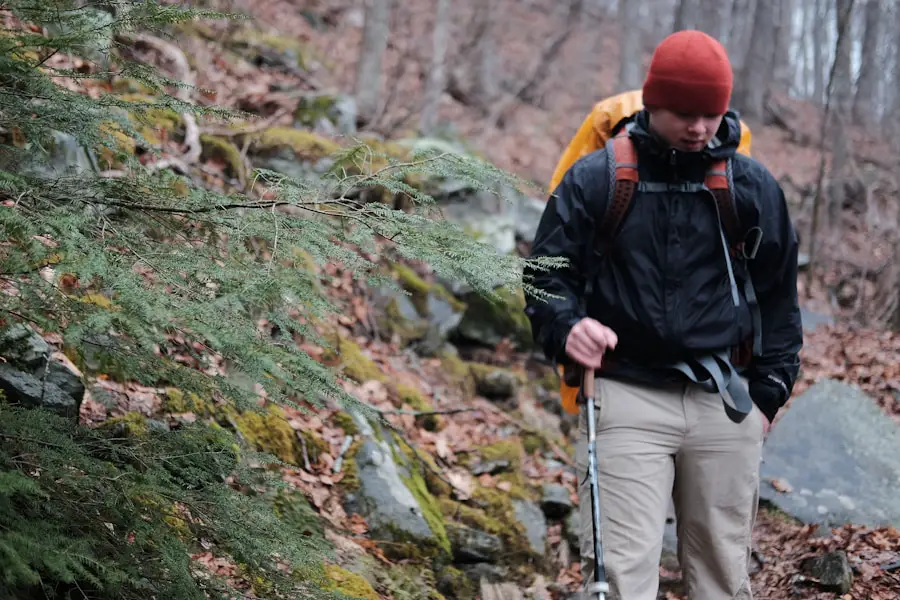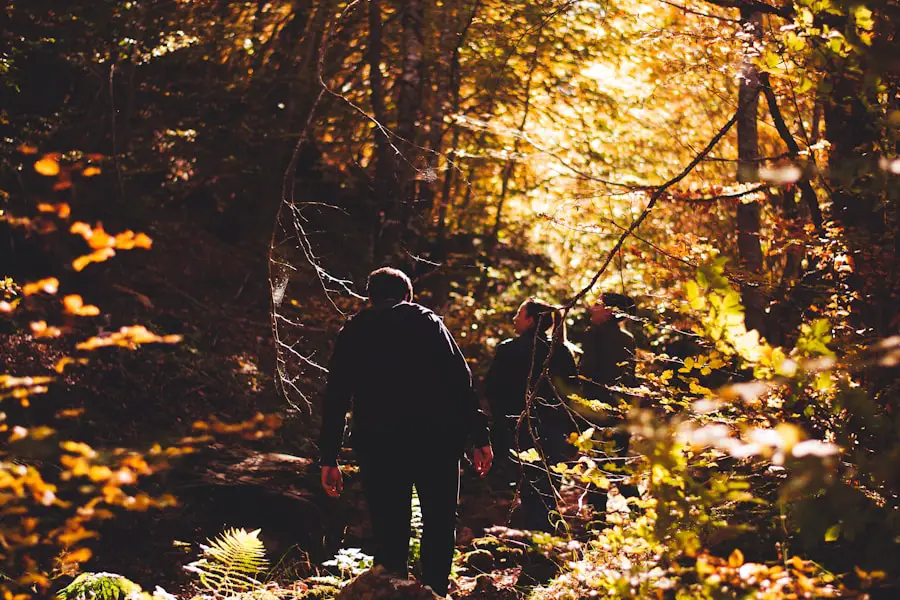As the leaves begin to change and the air turns crisp, fall hiking presents a unique set of challenges and rewards. One of the most critical aspects of preparing for a successful hike during this season is mastering the art of layering. The temperature can fluctuate dramatically throughout the day, especially in mountainous regions where elevation changes can lead to significant weather variations.
Therefore, understanding how to layer effectively is essential for maintaining comfort and ensuring an enjoyable experience on the trails. The foundation of any effective layering system is the base layer, which is designed to wick moisture away from the skin. Materials such as merino wool or synthetic fabrics like polyester are ideal for this purpose, as they help regulate body temperature while keeping you dry.
A long-sleeve shirt or thermal top can provide warmth without adding bulk, making it easier to move. Over this, a mid-layer such as a fleece or insulated jacket can trap heat and provide additional warmth when temperatures drop. Finally, an outer layer, typically a waterproof and windproof shell, protects against the elements.
This three-layer system allows hikers to adjust their clothing based on activity level and changing weather conditions, ensuring they remain comfortable throughout their journey.
Key Takeaways
- Layering is essential for fall hiking to regulate body temperature and stay comfortable.
- Consider waterproof and insulated footwear options for autumn trails to protect your feet from the elements.
- Invest in rain and wind protection gear such as a waterproof jacket and windproof pants for fall hiking.
- Choose a backpack with enough capacity and features like hydration compatibility for fall hiking.
- Accessories like a headlamp, first aid kit, and navigation tools are important for comfort and safety during fall hiking.
Footwear Options for Autumn Trails
Selecting the right footwear is paramount for fall hiking, as the trails can be damp and slippery due to fallen leaves and occasional rain. Hiking boots and shoes come in various styles, each designed for specific conditions and terrain. For those who prefer ankle support and stability, traditional hiking boots made from leather or synthetic materials are an excellent choice.
These boots often feature rugged outsoles that provide traction on uneven surfaces, which is particularly important when navigating through leaf-covered paths that may hide rocks or roots. Alternatively, trail running shoes have gained popularity among hikers who prioritize lightweight options and speed. These shoes typically offer a lower profile and are designed for agility on varied terrain.
However, it’s essential to ensure that they provide adequate grip and support, especially in wet conditions. Some brands have developed models specifically for fall hiking, incorporating features like water-resistant uppers and aggressive tread patterns to enhance performance on slippery surfaces. Regardless of the choice between boots or shoes, investing in high-quality footwear that fits well is crucial to prevent blisters and discomfort during long hikes.
Rain and Wind Protection Gear

Fall weather can be unpredictable, with sudden rain showers and gusty winds often catching hikers off guard. Therefore, having reliable rain and wind protection gear is essential for any autumn hiking adventure. A high-quality waterproof jacket is a must-have item in your gear collection.
Look for jackets made from breathable materials such as Gore-Tex or similar fabrics that allow moisture to escape while keeping rain at bay. Features like adjustable hoods, cuffs, and hemlines can enhance fit and prevent water from seeping in during downpours. In addition to jackets, consider investing in waterproof pants or overpants that can be easily packed away when not in use.
These can be particularly useful when hiking in areas where rain is common or when traversing through wet brush. Windbreakers are another valuable addition to your gear; they provide an extra layer of protection against chilly winds that can sap body heat quickly. When selecting wind protection gear, prioritize lightweight options that can be easily stowed in your backpack without taking up too much space.
Choosing the Right Backpack for Fall Hiking
| Backpack Feature | Importance |
|---|---|
| Capacity (liters) | 20-30 liters for day hikes, 40-50 liters for overnight trips |
| Weight | Lightweight for comfort during long hikes |
| Material | Durable and water-resistant for protection |
| Fit | Adjustable straps and padded back for comfort |
| Compartments | Multiple compartments for organization |
| Hydration Compatibility | Hydration bladder sleeve and ports for easy access to water |
A well-designed backpack is an essential component of any fall hiking setup, as it allows you to carry all necessary gear while maintaining comfort during your trek. When selecting a backpack, consider factors such as capacity, fit, and features tailored to autumn conditions. For day hikes, a pack with a capacity of 20 to 30 liters is often sufficient to hold essentials like water, snacks, extra layers, and safety gear without being overly cumbersome.
Look for backpacks with adjustable straps and padded hip belts to ensure a comfortable fit that distributes weight evenly across your body. This is particularly important when carrying heavier loads during longer hikes. Additionally, features such as hydration reservoirs or external pockets for water bottles can enhance convenience on the trail.
Some backpacks also come equipped with rain covers that provide an extra layer of protection against unexpected downpours, ensuring your gear remains dry even in inclement weather.
Accessories for Comfort and Safety
In addition to clothing and backpacks, various accessories can significantly enhance comfort and safety during fall hikes. One of the most important accessories is a good pair of trekking poles. These tools provide stability on uneven terrain and can help reduce strain on your knees during descents.
Adjustable poles are particularly beneficial as they can be tailored to your height and the specific conditions of your hike. Another essential accessory is a reliable headlamp or flashlight. As daylight hours shorten in the fall, having a dependable light source becomes crucial for navigating trails safely after sunset or during overcast days.
Look for models with adjustable brightness settings and long battery life to ensure you’re prepared for any situation. Additionally, consider carrying a first aid kit stocked with essentials like band-aids, antiseptic wipes, and blister treatment supplies. This small investment can make a significant difference in case of minor injuries or accidents on the trail.
Considerations for Cold Weather Hiking

As temperatures drop in the fall months, it’s vital to take specific precautions when hiking in colder conditions. Hypothermia and frostbite are real risks that can occur if hikers are not adequately prepared for chilly weather. One of the most effective ways to combat cold is by ensuring proper insulation through your layering system.
In addition to base layers that wick moisture away from the skin, consider using thermal leggings or tights under your pants for added warmth. Hand and foot protection is also crucial during cold weather hikes. Insulated gloves or mittens will keep your fingers warm while allowing for dexterity when handling gear or adjusting clothing layers.
Similarly, wearing thick wool socks can help maintain warmth in your feet while preventing blisters caused by moisture buildup. Gaiters are another useful accessory; they protect your lower legs from cold air and moisture while keeping debris out of your boots.
Gear for Fall Foliage Photography
Fall hiking offers breathtaking opportunities for photography enthusiasts eager to capture vibrant autumn colors. To make the most of these moments, it’s essential to have the right gear on hand. A lightweight camera tripod can stabilize your shots, especially in low-light conditions typical of overcast fall days or during early morning hours when the sun is just rising over the horizon.
In addition to a tripod, consider bringing along a polarizing filter for your camera lens. This accessory helps reduce glare from wet leaves and enhances color saturation, making those reds, oranges, and yellows pop in your photographs. A lens with a wide aperture will also allow you to capture stunning depth-of-field shots that highlight individual leaves against blurred backgrounds.
Don’t forget extra batteries and memory cards; colder temperatures can drain battery life more quickly than usual, so being prepared ensures you won’t miss capturing that perfect shot.
Tips for Packing and Organizing Your Fall Hiking Gear
Efficient packing and organization of your hiking gear can significantly enhance your overall experience on the trail. Start by laying out all your equipment before packing it into your backpack; this allows you to assess what you need versus what you might be able to leave behind. Use packing cubes or dry bags to separate clothing layers from food items and other essentials; this not only keeps everything organized but also makes it easier to access specific items without rummaging through your entire pack.
When packing your backpack, place heavier items closer to your back and center of gravity to maintain balance while hiking. Utilize external pockets for items you may need quick access to, such as snacks or a water bottle. Additionally, consider using carabiners or clips to attach items like trekking poles or jackets externally when not in use; this frees up space inside your pack while keeping everything within reach when needed.
By taking the time to pack thoughtfully and efficiently, you’ll set yourself up for a more enjoyable fall hiking experience amidst nature’s stunning seasonal transformation.
If you’re planning a fall hiking trip, it’s important to dress appropriately for the changing weather. One helpful article to check out is “Best Time to Travel to Santa Fe: A Seasonal Guide” which offers insights on the weather conditions in Santa Fe during the fall season. This can give you a better idea of what to expect and how to dress accordingly for your hiking adventure. Make sure to pack layers, sturdy hiking boots, and clothing that can wick away moisture to stay comfortable on the trails. Check out the article here for more tips on dressing for fall hiking.
FAQs
What should I wear for hiking in the fall?
In the fall, it’s important to wear layers for hiking. Start with a moisture-wicking base layer, add a insulating layer, and finish with a waterproof and windproof outer layer. Don’t forget to wear comfortable and supportive hiking boots.
What type of fabric is best for fall hiking clothing?
For fall hiking, it’s best to choose clothing made from moisture-wicking and quick-drying fabrics such as merino wool, polyester, or nylon. These fabrics will help keep you dry and comfortable during your hike.
Should I wear shorts or pants for fall hiking?
In the fall, it’s best to wear hiking pants to protect your legs from the elements and potential hazards on the trail. Look for pants that are made from quick-drying and water-resistant materials.
Do I need to wear a hat for fall hiking?
Wearing a hat is a good idea for fall hiking to keep your head warm and protect you from the sun. Look for a hat that provides both warmth and sun protection.
What type of socks should I wear for fall hiking?
For fall hiking, it’s best to wear moisture-wicking and cushioned hiking socks to keep your feet dry and comfortable. Avoid cotton socks, as they can retain moisture and lead to blisters.
Should I bring a backpack for fall hiking?
Yes, it’s important to bring a backpack for fall hiking to carry essentials such as water, snacks, a map, a compass, a first aid kit, and extra layers of clothing. Look for a backpack that is comfortable and has enough room for your gear.
